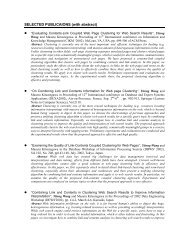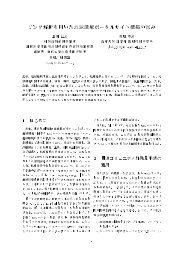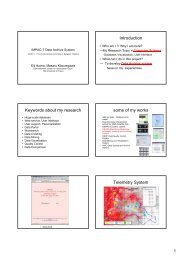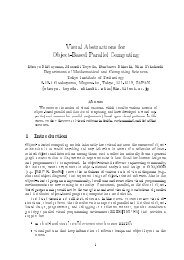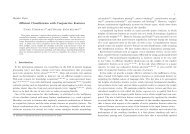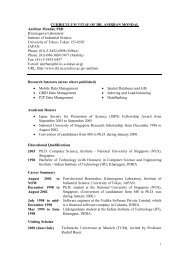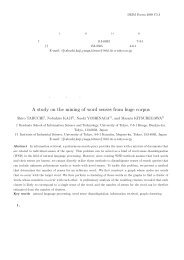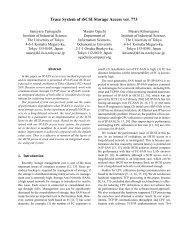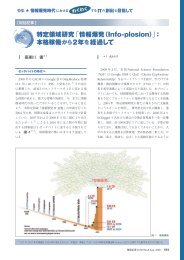Special Issue on Information Explosion
Special Issue on Information Explosion
Special Issue on Information Explosion
Create successful ePaper yourself
Turn your PDF publications into a flip-book with our unique Google optimized e-Paper software.
212 M. Kitsuregawa and T. Nishida<br />
must be made in the daily life of patients out of hospitals. We c<strong>on</strong>ducted two<br />
verificati<strong>on</strong> studies: <strong>on</strong>e for metabolic syndrome, which was shown as the main<br />
cause of diabetes in recent studies as obesity with visceral fat accumulati<strong>on</strong>, and<br />
another for diabetes.<br />
The first study aimed at managing metabolic syndromes. We asked <strong>on</strong>e<br />
hundred m<strong>on</strong>itors to wear activity sensors and pulse rate sensors, and to use<br />
wireless weight scales and blood pressure sensors for 11 days. On the 6th day,<br />
health instructors suggested lifestyle problems, up<strong>on</strong> the sensor data, to the m<strong>on</strong>itors.<br />
The sensed data were automatically uploaded to the server via Bluetooth<br />
or wireless LAN. The result showed that 91.6 % of the m<strong>on</strong>itors increased their<br />
amount of exercise (9.55 % increase in average (n = 83)) after the healthcare<br />
instructi<strong>on</strong>. In the analysis of the kinds of activities, “standing” and “walking”<br />
were increased, and “using elevator” was apparently decreased in daily behaviors.<br />
Additi<strong>on</strong>ally, we could estimate the optimizati<strong>on</strong> of health instructi<strong>on</strong>s<br />
in both time and accuracy, which should lead to enormous cost reducti<strong>on</strong> of<br />
Particular Health Checkup System held all over Japan.<br />
The sec<strong>on</strong>d study targeted <strong>on</strong> diabetics. We used activity sensors, blood<br />
sugar sensors, weight scales, and blood pressure sensors. The former two were<br />
mobile, and all the data were uploaded via mobile ph<strong>on</strong>es or wireless LAN. The<br />
mobile ph<strong>on</strong>e had an applicati<strong>on</strong> to show the recommendati<strong>on</strong> message either<br />
triggered by the sensor data or sent daily. As the result, we found a critical<br />
case of reverse white coat hypertensi<strong>on</strong>, where the blood pressure is high <strong>on</strong>ly at<br />
out of hospital. Moreover, according to the analysis of recommendati<strong>on</strong> effect,<br />
the frequency of measuring vital informati<strong>on</strong> increased after a recommendati<strong>on</strong>,<br />
and several messages certainly increased the amount of activities, and several<br />
decreased. These results have not been found in our studies so far without<br />
such an envir<strong>on</strong>ment. In additi<strong>on</strong>, we developed a collecting system of activity<br />
informati<strong>on</strong> using smart ph<strong>on</strong>es, and gathered well-labeled 3D accelerometer<br />
data of 150 people. Since smart ph<strong>on</strong>es have been deployed tens of milli<strong>on</strong>s in<br />
the world, they can be a global platform for progress of activity recogniti<strong>on</strong>.<br />
Papers in This <str<strong>on</strong>g>Special</str<strong>on</strong>g> <str<strong>on</strong>g>Issue</str<strong>on</strong>g><br />
This special issue c<strong>on</strong>tains five papers. The first paper 9) addresses automated<br />
c<strong>on</strong>structi<strong>on</strong> of a semantic network by making use of the huge informati<strong>on</strong><br />
resource of the Web. The challenge of this work is to go bey<strong>on</strong>d the c<strong>on</strong>venti<strong>on</strong>al<br />
keyword-based Web search, to enable the user to find informati<strong>on</strong> that <strong>on</strong>e might<br />
not even know. The main c<strong>on</strong>tributi<strong>on</strong> of this work is the development of the<br />
collective body of knowledge acquisiti<strong>on</strong> methods for automatically generating<br />
TORISHIKI-KAI, a machinery that maps out the c<strong>on</strong>text of use or handling of<br />
the topic the user inputs, and classifies topically related search terms according<br />
to semantic categories.<br />
The sec<strong>on</strong>d paper 10) presents a model-based approach to fault localizati<strong>on</strong><br />
that allows the human analyst to narrow down the fault localizati<strong>on</strong> in largescale<br />
computing envir<strong>on</strong>ments. Localizati<strong>on</strong> is regarded as anomaly detecti<strong>on</strong><br />
problems in system behaviors by automatically analyzing data resulting from



